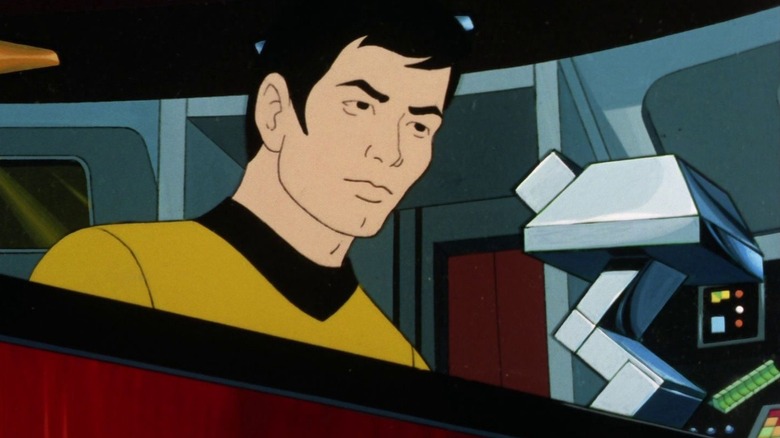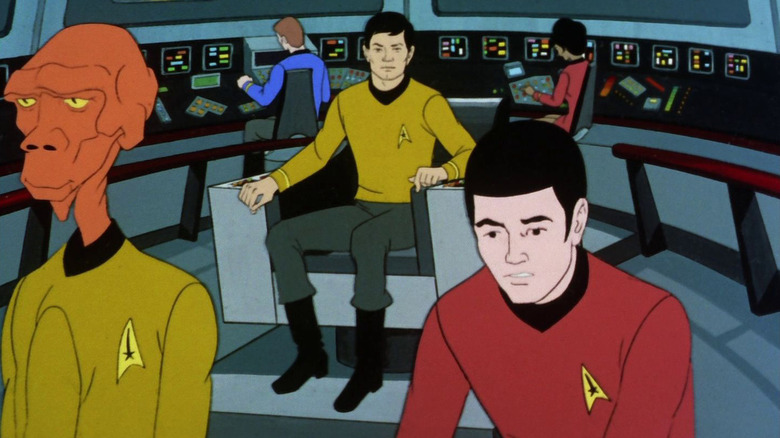Why Star Trek: The Animated Series Was Dissatisfying For George Takei
Perhaps the most overlooked series in the "Star Trek" canon ("Short Treks" and "Very Short Treks" notwithstanding), "Star Trek: The Animated Series" may be accepted as the final two years in the U.S.S. Enterprise's five-year mission. "Star Trek: TAS" debuted on September 8, 1973, four years after the cancelation of "Star Trek," to reunite the original cast and writers to explore Starlfeet's adventures in a 30-minute, animated format. The animation was provided by Filmation, the studio that had previously overseen multiple Batman and Superman cartoons, Archie cartoons, "Gilligan's Island" spinoffs, and which would go on to produce the ultra-popular "Fat Albert," "The Groovy Goolies," "BraveStarr," and "He-Man and the Masters of the Universe." Filmation shows were popular among kids, but their animations tended to be stiff and inexpressive. The most prominent feature of "Star Trek: TAS" is how static it looks.
However, the shortened runtime forced the writers of "TAS" — most of them veterans of the original show — to trim out a lot of the excess, get straight to the story, and to the heady sci-fi concepts embedded therein. This may be a daring declaration, but "TAS" was better written than "Star Trek." Additionally, the animated format allowed for wilder ideas to be tinkered with. Episodes could now take place underwater or on worlds that didn't look like Southern California. Aliens could now be humanoid plants, possess multiple limbs, or be 50 feet tall.
Walter Koenig was unfortunately excluded from "TAS," but Majel Barrett, James Doohan, William Shatner, Nichelle Nichols, Leonard Nimoy, DeForest Kelley, and George Takei all returned to reprise their original roles. In the cases of Barrett and Doohan, they played dozens of new roles as well.
For Takei, though, "TAS" wasn't fun. In an interview with Starburst Magazine, Takei recalled the gig being a lonesome affair.
George Takei disliked recording alone
It's unusual when an animated series of feature film allows all of its voice actors to convene in one place and record together. There are exceptions, of course: Mark Hamill and Kevin Conroy famously recorded together on "Batman: The Animated Series," John Goodman and Billy Crystal recorded together for "Monsters, Inc.," and the principal cast of "The Simpsons" once recorded in unison. Meanwhile, shows like "Futurama," the new "DuckTales," "Animaniacs" (the Yakko/Wakko/Dot segments), "Adventure Time," "Steven Universe," and "The Powerpuff Girls," always record with the entire cast present.
"Star Trek: TAS," however, was made with efficiency in mind, and group recordings didn't fit into that ethos. Each individual actor would take turns in the recording booth, reading on their own lines before going home. Takei hated that, feeling it to be lonely; we was used to acting with co-stars on a set, not merely reading lines into a can. He said:
"It was not as satisfying as the live-action, because then we were there on the set together, playing scenes with each other. With the animated version, when I arrived at the recording studio, Leonard might be leaving, and I would step into the booth and do just my lines. The scene might be with Leonard or with Nichelle, but it would only be me alone with my lines highlighted. Then when I'm finished and leaving, Jimmy Doohan would be coming in, so it was not a very fun way of working."
The live-action shoots weren't always great either, and Takei recalls some very late nights on the original set, but he still enjoyed the process and walked away from "Star Trek" with mostly pleasant memories. His biggest regret was that there was never a Captain Sulu TV series that spun off from "Star Trek VI: The Undiscovered Country."

